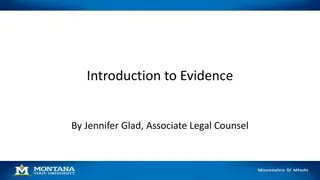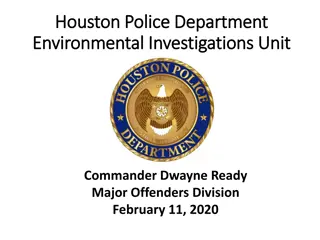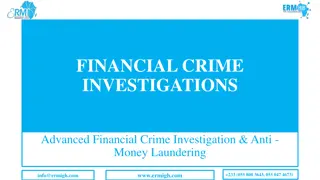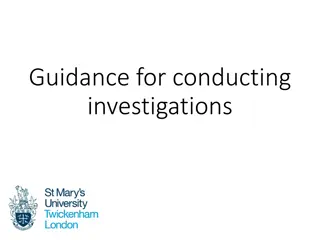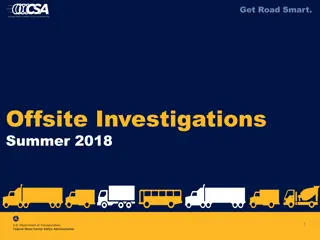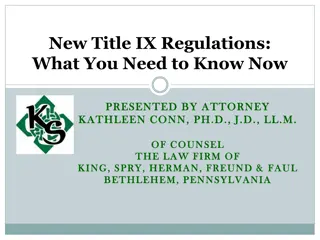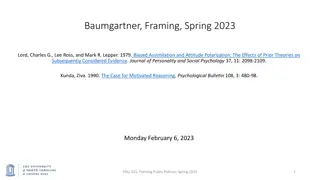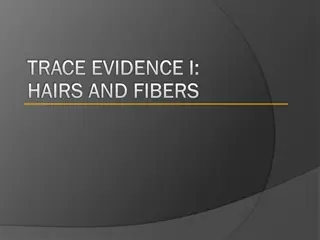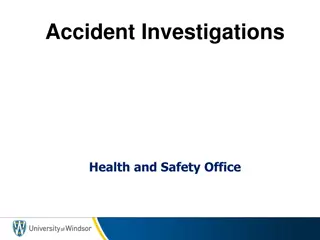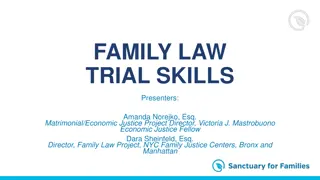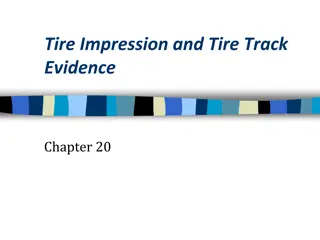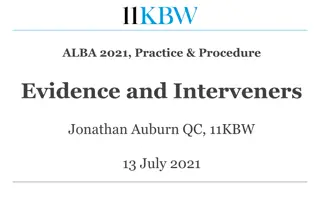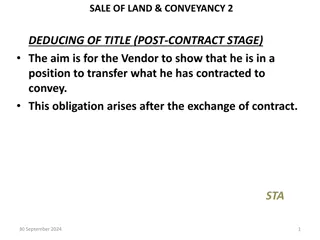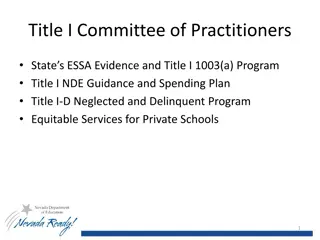Understanding Title IX Investigations and the Role of Evidence Collection
The purpose of a Title IX investigation is to collect relevant evidence, both inculpatory and exculpatory, to allow for impartial decision-making regarding reported sexual harassment cases. Parties involved must receive sufficient notice and have opportunities to participate, present statements, and review evidence. The burden of evidence gathering lies on schools, not the parties, with the goal being a truth-seeking mission for a neutral decision-maker to reach an accurate determination.
Download Presentation

Please find below an Image/Link to download the presentation.
The content on the website is provided AS IS for your information and personal use only. It may not be sold, licensed, or shared on other websites without obtaining consent from the author. Download presentation by click this link. If you encounter any issues during the download, it is possible that the publisher has removed the file from their server.
E N D
Presentation Transcript
Title IX Investigations and Relevance Sarah G. Mudd David W. Parrott February 18, 2021
For the institution To collect relevant inculpatory and exculpatory evidence Sufficient to permit an impartial decision- maker to determine Whether or not the reported sexual harassment occurred What is the Purpose of an Investigation? From Husch Blackwell Presentation 2020
Parties must have sufficient notice to prepare and meaningfully participate Investigator has an independent duty to collect relevant inculpatory and exculpatory evidence Parties have an equal opportunity to present their statements, evidence, and to identify witnesses Parties have equal opportunity to review and comment on evidence developed Investigation is evidence-gathering; not fact-finding What are the General Principles of an Investigation? From Husch Blackwell Presentation 2020
The burden of gathering evidence must remain on schools not the parties 106.45(b)(5)(i) Both parties have the right to provide evidence and witnesses (both fact and expert), 106.45(b)(5)(ii) (but it is not their responsibility to do so) Burden of Gathering Evidence
It is the schools job to conduct the investigation, track down and gather all of the evidence possible and interview witnesses Role of the University; Goal of the Investigative Mission The school is neutral during this process, they are not focusing on gathering evidence to prove respondent guilty or to prove respondent is not responsible; they are not building a case The goal is a truth-seeking mission; gather everything relevant so that a neutral decision maker can reach an accurate determination based on the information presented during a hearing.
Schools must send the parties and their advisors: ALL evidence directly related to the allegations will include relevant and irrelevant evidence including that which would otherwise be excluded under the rape shield protections includes evidence the school will not use/rely in making a decision includes inculpatory or exculpatory evidence whether obtained from a party or other source electronic format or a hard copy, otherwise, method and format of delivery up to school Investigation Requirements Right to Inspect Evidence 106.45(b)(5)(vi) parties must have at least 10 days to submit a written response the investigator will consider parties input prior to completion of the investigative report Relevant evidence must be made available at hearing
Create an investigative report that fairly summarizes relevant evidence and, at least 10 days prior to a hearing (if a hearing is required under this section or otherwise provided) or other time of determination regarding responsibility, send to each party and the party s advisor, if any, the investigative report in an electronic format or a hard copy, for their review and written response. Final Investigative Report 106.45(b)(5)(vii)
Schools must not restrict the ability of the parties to discuss the allegations or gather evidence (no gag orders) Parties have the right to discuss the allegations with anyone they choose with limited exceptions: Right to Discuss Allegations and Gather Evidence 106.45(b)(5)(iii) no-contact directive retaliatory manner
The following are the most common standards of proof from lowest to highest. The standard that applies depends on the type of case. The more serious the consequences, the higher the standard of proof is likely to be. Potential loss of liberty (jail or prison), for example, involves a higher standard of proof than a lawsuit for money. Reasonable Suspicion and Probable Cause This standard is most commonly utilized prior to a criminal trial and are most often at issue when responding to motions to suppress evidence. Preliminary hearings also involve a determination of probable cause and search warrants are issued using a probable cause standard. Substantial Evidence This standard falls between probable cause and preponderance of the evidence and requires more than a mere scintilla of evidence. Substantial evidence is such relevant evidence as a reasonable mind might accept as adequate to support a conclusion. (Richardson v. Perales, 402 U.S. 389 (1971).) Standards of Proof Preponderance of the Evidence The preponderance-of-the-evidence standard is utilized for most civil lawsuits. Preponderance of the evidence is met if the decision-maker believes the evidence shows the person charged is more likely than not more than 50% likely to be responsible. Clear and Convincing Evidence The clear-and-convincing-evidence standard goes by descriptions such as clear, cogent, unequivocal, satisfactory, convincing evidence. Clear and convincing means the evidence is highly and substantially more likely to be true than untrue; the decision-maker must have an abiding conviction that the truth of the factual contention is highly probable. This standard requires that the evidence show that it is highly probable or probably certain that the thing alleged has occurred. Beyond a Reasonable Doubt Beyond a reasonable doubt is the highest legal standard. This is the standard the U.S. Constitution requires the government to meet in order to prove a defendant guilty of a crime. (In re Winship, 397 U.S. 358, 364 (1970).) The evidence must be so convincing that no reasonable person would ever question the defendant s guilt. The standard requires that the evidence offer no logical explanation or conclusion other than that the defendant committed the crime. This highest of standards requires after consideration of all facts only one logical conclusion: that the defendant is indeed guilty. Courts sometimes describe this level of confidence in a verdict as a moral certainty.
Relevance, in the common law of evidence, is the tendency of a given item of evidence to prove or disprove one of the legal elements of the case, or to have probative value to make one of the elements of the case likelier or not. Probative is a term used in law to signify "tending to prove". Relevance Defined in Legal Terms
Evidence is relevant if: it has any tendency to make an allegation more or less probable than it would be without the evidence; and It is of consequence in determining the action. Relevance Defined in General Terms
Information tending to support the proposition a respondent committed sexual harassment as alleged What is Inculpatory Evidence? Example: A text message sent the day after an incident from the respondent stating: I never should have forced you to have sex withme after yousaid no. I m so sorry for what Idid. From Husch Blackwell Presentation 2020
Information tending to support that the respondent did not commit sexual harassment as alleged What is Exculpatory Evidence? Example: A text message sent the day after an incident from the complainant stating: I know that I said yes at the time. And I knew what I was doing. But now I feel like you just used me as a one-night- stand. From Husch Blackwell Presentation 2020
Investigator? Complainant? Respondent? Witnesses? Investigative Report? Police Report? All of the above??? Who determines the facts of the case?
Criminal: The jury is the fact-finder, but it is left to "find" facts only from the evidence which is legally admissible. The judge instructs the jury on the legal principles or rules that must be followed in weighing the facts. If the jury finds the accused guilty, it is up to the judge to sentence the defendant. Who determines the facts of the case in criminal cases? www.americanbar.org
Civil: Who determines the facts of the case in civil cases? the jury is the fact finder who decides which party's version of the facts to believe and who ultimately wins or loses. www.civillawselfhelpcenter.org
Student Title IX case: Who determines the facts of the case in Title IX Student Conduct cases? The hearing board or hearing officer are the fact-finders, but they are left to "find" facts only from relevant evidence presented in a hearing. There are two individuals who determine relevancy: the investigator and the Chair of the Hearing Board or Hearing Officer
Relevancy Determination Process How to determine relevancy: 1. Review the evidence being offered 2. Consider the allegations of the Title IX sex harassment complaint 3. Ask yourself whether the evidence being offered has the potential to prove/explain or disprove an incident under investigation
The Relevancy Determination Process allows/requires you to apply your education, experience, training, and expertise to your decision-making process. When asked in an OCR Complaint Investigation or in litigation about how you reached a conclusion about relevancy (or anything else for that matter), your ability to demonstrate that you were reasonable (that is, you reasoned your way to a decision) by applying your education, experience, training, and expertise will serve as a protection for you. Relevancy Determination Process: Pro Tip
Initial Relevancy Analysis of Scenario A Step 1 (review the evidence): Applying the Relevancy Determination Process Step 2 (consider the Title IX complaint): Step 3 (assess whether evidence potentially proves/disproves an incident of the Title IX Complaint): Scenario A
Initial Relevancy Analysis of Scenario B Step 1 (review the evidence): Applying the Relevancy Determination Process Step 2 (consider the Title IX complaint): Step 3 (assess whether evidence potentially proves/disproves an incident of the Title IX Complaint): Scenario B
Title IX Rape Shield Protections Every relevance analysis in a Title IX Sex Harassment investigation must also include a consideration of Title IX's rape shield protections.
Title IX Rape Shield Protections Continued Title IX's rape shield protections provide that questions and/or evidence about the Complainant s sexual predisposition or prior sexual behavior are presumptively not relevant, unless they are offered under two limited exceptions.
Rape Shield Exceptions: Evidence/questions regarding a Complainant s sexual predisposition or prior sexual behavior may be deemed relevant only if: Title IX Rape Shield Exceptions 1. The questions and evidence are offered to prove that someone other than the Respondent committed the conduct alleged by the Complainant; or 2. The questions and evidence relate to specific incidents of the Complainant s prior sexual behavior with respect to the Respondent and are offered to prove consent
Review the evidence being offered Title IX Rape Shield Protections Relevancy Analysis Process Consider the allegations of the Title IX complaint Ask yourself whether the evidence being offered has the potential to prove/explain or disprove an incident under investigation Consider whether evidence falls into rape shield protections or rape shield exceptions
Applying the Title IX Rape Shield Protections Relevancy Analysis Process
Initial Relevancy Analysis of Scenario C Step 1 (review the evidence): Applying the Relevancy Determination Process Step 2 (consider the Title IX complaint): Step 3 (assess whether evidence potentially proves/disproves an incident of the Title IX Complaint): Scenario C Step 4 (assess whether evidence meets exceptions under Rape Shield):
Initial Relevancy Analysis of Scenario D Step 1 (review the evidence): Applying the Relevancy Determination Process Step 2 (consider the Title IX complaint): Step 3 (assess whether evidence potentially proves/disproves an incident of the Title IX Complaint): Scenario D Step 4 (assess whether evidence meets exceptions under Rape Shield):
The purpose of having restrictions placed on evidence that can be introduced is to prevent the fact finders from making decisions based on factors other than what is relevant. The goal is a truth-seeking mission; gather everything relevant so that a neutral decision maker can reach an accurate determination based on the information presented during a hearing. Why Does Relevance Matter?
The purpose of an investigation is to collect relevant inculpatory and exculpatory evidence sufficient to permit an impartial decision-maker to determine whether or not the reported sexual harassment occurred. The burden of gathering evidence must remain on schools not the parties 106.45(b)(5)(i) Summary It is the school s job to conduct the investigation, track down and gather all of the evidence possible and interview witnesses The goal is a truth-seeking mission; gather everything relevant so that a neutral decision maker can reach an accurate determination based on the information presented during a hearing. Evidence is relevant if it has any tendency to make an allegation more or less probable than it would be without the evidence; and it is of consequence in determining the action.
The hearing board or hearing officer are the fact-finders, but they are left to "find" facts only from relevant evidence presented in a hearing. There are two individuals who determine relevancy: the investigator and the Chair of the Hearing Board or Hearing Officer. Determine relevancy by reviewing the evidence being offered; . considering the allegations of the Title IX sex harassment complaint; and asking yourself whether the evidence being offered has the potential to prove/explain or disprove an incident under investigation. Summary- Continued Title IX's rape shield protections provide that questions and/or evidence about the Complainant s sexual predisposition or prior sexual behavior are presumptively not relevant, unless they are offered under two limited exceptions. Reason your way to a relevancy decision by applying your education, experience, training, and expertise to your decision-making process..

 undefined
undefined








